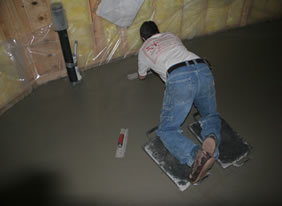Adding Fly Ash to Concrete
There are environmental benefits of using fly ash in your concrete. Tell your concrete contractor that you want to use fly ash in your concrete. He/she may resist because it is not something they are used to doing. Insist and give them this info. The use of fly ash creates significant benefits for our environment.
1. Using fly ash in concrete means we need less concrete. Concrete production is a major cause of greenhouse gas emissions. 2. Using fly ash in concrete reduces the disposal needs of power plant waste.
What is fly ash? Power plants that burn coal account for more than half of the electricity produced in the United States . These power plants also produce residual materials like fly ash (which is captured from the exhaust of the boiler) and bottom ash (which is heavier and falls to the bottom of the boiler). These and other “coal combustion products” were originally treated as waste and disposed of in landfills.
Performance of Fly Ash Concrete
Fly ash use improves concrete performance making it stronger, more durable, and more resistant to chemical attack. Fly ash – the most commonly used coal combustion product – is a remarkable material that cost-effectively improves the performance of products it is added to.
Environmental Benefits of Using Concrete.
While using concrete does cause major environmental problems, there are Earth friendly benefits to using concrete over other products. Concrete itself is an environmentally sound building material. Roads and structures built from concrete last longer and require less maintenance than other materials. When used in freeways, concrete can result in less vehicle fuel consumption. Because concrete reflects light, less energy is needed to illuminate the roadway. Concrete is recyclable, with 45 to 80 percent of crushed concrete usable as aggregate in new construction.
Additionally, recent studies conducted by the Environmental Council of Concrete Organizations have determined certain metropolitan areas experience higher overall temperatures than surrounding less-developed areas. Using lighter colored concrete products instead of asphalt pavement can help reduce excessive temperature, further conserving energy.
Tuesday, 20 degrees Fahrenheit.
Pumper truck arrives 7:30am. First cement truck arrives 8:00am.
Ready to pour. The driver controls the cement truck from inside his cab.
The pumper truck, hopper, & cement flow is controlled from the operator inside the dome.
A “slurry” mix of water & concrete is pumped through the hose to get started – then the action begins.
The pump actually shoots the concrete out 8′-10′.
A laser beam with a remote sensor on the rod is used to check the height of the concrete.
A power screed is used to level the first time.
Work progresses quickly while the crowd looks on.
“Zip strip” control joints are placed to control drying cracks.
The total pour involves approximately 2100 SQ. FT. With footings the total is 40 cubic yards.
The final few yards are poured directly from the truck chute. Sam’s Masonry workers back themselves out the door at 10:15am. Without the pumper truck, they would still be wheelbarrowing concrete.
Now we wait a few hours.
The entire slab was finished with a circular power trowel and then hand troweled because we are going to stain the concrete as the final floor finish in all the rooms.
Anyone for roller skating? We had to scratch the proverbial dedication into the concrete as the final step.



























